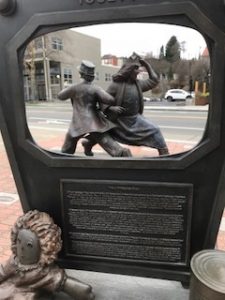On North 36th Street, underneath the Aurora Bridge, lives the Fremont Troll.
The Norwegian folk tale about a large and ugly troll living under a bridge and the three hungry billy goats who are afraid to cross is forever immortalized in this iconic statue designed and executed by Professor of Architecture Steve Badanes and his students at the University of Washington, in response to a contest sponsored by the Fremont Arts Committee. Intended to fill up a “problem area” below the Aurora Bridge, the popular Fremont Troll was dedicated October 31, 1990 and continues to attract hundreds of visitors (and locals) with their cameras every year.
In the years before it was made into Highway 99, Aurora Avenue was an ordinary residential street. Its last segment in Fremont is now underneath the Aurora Bridge. In the year 2005 the City of Seattle passed an ordinance to rename this two-block segment of Aurora between North 34th to 36th Streets “Troll Avenue” to help people find the Troll artwork at the intersection of North 36th Street.

